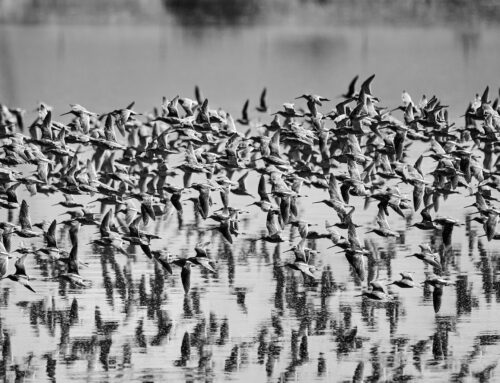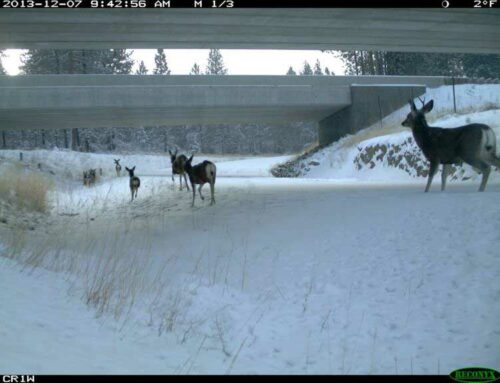By Dave Ferguson
One crisp January afternoon, as the sun tapered across our rose-colored living room wall, an alarming “thud” startled me and my wife from our private world of books.
“What was that?” Jane shouted, swapping her reading glasses for her distance glasses.
“I don’t know,” I said, as I leapt from my reclining chair to peer out the picture window, sending Murakami’s Windup Bird Chronicle thumping to the floor.
Dumbfounded, I stared, scanning left, right. I scratched my white beard, stroked my hairless head, and said, “Nothing,” with a hint of question.
Nothing, that is, other than the bright red fruit on the mountain ash standing leafless in the center of our front yard. From its branches a small flock of birds arose, all at once, scattering to the sky. High-pitched trills, “bzeee, bzeee,” and faint sighing whistles faded with distance.
As silence returned, I noticed, below the window, in the wintery green grass of Oregon, a lifeless looking brown bird. Periodically it shuddered. Slowly, it came back to life, wobbling up onto its wirelike legs and clawed toes. Then it hopped, unsteadily, and in no particular direction.
“A bird,” I said, as if uttering a verdict.
“Is it injured?” said Jane, pulling her emerald turtleneck up over her chin as she stepped before the fireplace, crossing her arms.
“Maybe,” I guessed.
Suddenly, the bird flew up, right before my eyes. I delighted at the lemon yellow dabs on the tip of the tail that so elegantly accented its silky brown body. The tips of the wings flashed red, just a few dots, as if from a Fauvist’s finest brush. On its cinnamon-crested head I admired the rakish black mask around its eyes, bordered by the thinnest of white lines. It looked as if it was off to a costume ball, now flying hurriedly to avoid arriving late.
“What kind?” Jane asked.
“I’d like to know,” I replied, “a real beauty.”
“Well, we should find out,” said Jane.
“Let’s,” and after a moment’s reflection, “will the Nature Store be open?”
“Sure, it’s just four,” said Jane.
“Well, we should have a bird book anyway,” I concluded.
Thus, we began birdwatching: time to take the binoculars out of the closet.
We’d recently retired, and had written “birding” on the list of activities we’d planned to add to our calendar. Now, unlike just a year prior, open time slots beckoned, invitingly, like blank checks.
Erik, our flannel-shirted clerk smiled broadly through his black beard as he recommended the National Geographic Field Guide to the Birds of Western North America. The boards of the Nature Store’s hardwood floor creaked as Jane and I huddled closer. With the eraser end of a pencil Erik tapped at the glossy illustrations.
“Look how the arrows point at the differences between the smaller-headed Sharp-shinned Hawk and its longer-necked cousin, the Cooper’s Hawk.”
“Right,” I replied, hoping to conceal my ignorance.
At the end of the bookshelf, in the space between two smartly colored National Geographics, balanced a single, slim pamphlet in black and white, Birds of Jackson County, Oregon: Distribution and Abundance. I flipped it open.
“What do you think of this?” I asked.
“Now that would make a nice companion to the Geographic. It narrows identification down to local birds. And this key tells you the habitat for each species. See, ‘O’ for oak savanna, ‘R’ for riparian.”
“’H’ for…?” I asked.
“Human habitats, urban or park. Now look at these graphs. They go from January to December and the black bar gets narrow or thick or absent indicating the abundance for each species each month of the year.”
“Looks handy,” I thought aloud.
Back home I returned to my recliner, attempting to solve the afternoon’s mystery. “Suspects: 431 pages of birds. Hmm,” I muttered.
“There must be a key,” Jane offered, “like the flower book. It has a key.”
“Sure,” I said, eventually discovering that the back cover unfolded, “Here it is, ‘Visual Index to Bird Families.’”
“Let’s see,” Jane said, looking over my shoulder.
My index finger haltingly scanned back and forth across 60 miniature bird images arranged in five lines, eventually coming to rest between the Wagtails and Wood Warblers.
“I think it’s a Waxwing,” I said.
Turning to page 326, I verified the features, “Brown, yellow, red, and oh, look at that mask. Definitely!”
“But which,” Jane asked, “‘Bohemian’ or ‘Cedar?’”
“I wonder… Hey, we can consult the Jackson County pamphlet,” I replied.
Page 31 (of just 34 pages!) answered our query.
Cedar Waxwing: common year-round, breeds locally, in human habitats.
Bohemian Waxwing: rarely sighted.
With that I had an insight: why not combine the two books? With some old style cut and paste, I could annotate the National Geographic with the Jackson County graphics. Each ‘distribution and abundance graph’ was only half an inch tall and two inches wide; I could paste them page-by-page right beneath their corresponding illustrations. That way I could ignore non-local species, so thoroughly cataloged in the encyclopedic Geographic. I’d quickly see the likelihood of spotting a given bird in a given place at a given time, say, a Cedar Waxwing in my front yard in January.
Over the next two days I strained my eyes, coaxing right angles from Jane’s sewing scissors, while stickying my fingers with Elmer’s. In the end I’d created a personally designed, annotated edition: Jackson Geographic.
The following afternoon the cedar waxwings returned to the mountain ash. Just twenty feet away, Jane and I stood behind the window, side-by-side, binoculars at salute position. We traded turns calling out the markings.
“Cinnamon crest.”
“Yellow-tipped tail.”
“Black face mask.”
“Red wing tips.”
The Waxwings hopped busily from branch to branch, plucking red berries with their forceps-like beaks. They held each oversized bite for a moment, delicately touching the prize with the thinnest of tongues – which were surprisingly red – before swallowing the morsel whole.
“The berries, the birds wait until the berries ripen and ferment,” Jane explained, “It’s their version of wine.”
“It’s their happy hour!” I added.
Suddenly Jane exclaimed, “Look, look, look! See the birds in a row. I read about this. They’re sharing.”
Just in time, I focused my binoculars on three birds perched side-by-side. A cluster of a dozen red fruits drooped at the branch’s end. The outermost bird tugged a berry free and held it high in its upturned bill. It then swiveled to face its neighbor and delivered the parcel to a waiting beak. This bird then repeated the act, offering the gift to a third bird. Upon receiving its communion, number three threw back its head, gulped down the berry, and shivered from head to tail.
Keeping our binoculars trained, Jane and I touched elbows.
Nudging me, Jane said, “Speaking of happy hour…”





Leave A Comment
You must be logged in to post a comment.